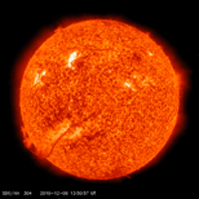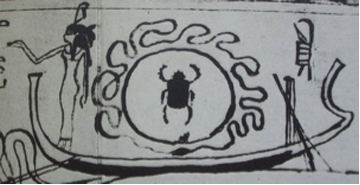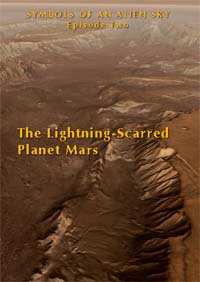|
 
Left: a solar prominence detaching
itself from the sun (6 December
2010).
© NASA’s Solar Dynamics Observatory.
Right: detail from the papyrus of
B_k-n-Mw.t, Egypt (Tenth century
BCE).
Museum of Egyptian Antiquities,
Cairo, Egypt.
Going Round the Sun in Circles
Mar 14, 2011
Sometimes science is served
better by questions than answers.
When crossing the threshold between
familiar physics and uncharted
territory, contemplating
possibilities that are theoretically
plausible but so far unexplored or
untested, premature conclusions can
be more detrimental than carefully
framed questions transcending
existing boundaries of feasibility.
On the morning of 26 June 1873, two
citizens of Fort Scott, Kansas
(37º50´ N, 94º42´ W), recorded an
unusual appearance of the rising
sun:
“The sky was clear, and the sun rose
entirely unobscured. When the disk
of the sun was about half way above
the horizon, the form of a huge
serpent, apparently perfect in form,
was plainly seen encircling it, and
was visible for some moments.”As
the pair were “willing, if
necessary, to make affidavit of
their assertions” and the editor of
the local paper had “all confidence
in the credibility of our
witnesses,” this tidbit of
information may conceal a genuine
transient phenomenon on the sun –
but what could that have been?
Certainly the sun was all but calm
at the time of the sighting. The
“serpent” was seen during the
maximum of solar cycle 11, the cycle
following the one that saw the
famous Carrington event, transpiring
about 1.5 years after the great
low-latitude aurora of 4 February
1872, which was recently
characterised as “the greatest of
the modern epoch, surpassing that of
1859,” and “perhaps the most
extensive in relatively recent
times.”The observation of the
solar “serpent” from Kansas
coincides with a flurry of notable
aurorae that occurred between 18 and
27 June 1873. One experienced
observer, Minerva Emily Wing
(1833-1881), of West Charlotte,
Vermont, stationed at a latitude of
44º19´ north, recorded an “aurora
all night” on 22 and 23 June and
characterised the peak occurrence on
the 25th. as the “most brilliant
aurora of this year,” having the
“form of an arch, with short beams
playing on both sides up and down …”
As this “most brilliant aurora”
occurred one or perhaps two nights
before the two witnesses at Fort
Scott spotted their “huge serpent”
encircling the sun, it is tempting
to infer that the “serpent” was a
solar prominence producing or
coinciding with a coronal mass
ejection intense enough to last
while some of the expelled plasma
had already reached the earth.
Allowing that a filament undulating
around only the upper half of the
solar disc could adequately be
described as “encircling” it, the
morphology of solar filaments lends
itself well to naïve or casual
comparison to a snake. This was
illustrated most recently in the
formation of a “‘mega-filament’ of
solar magnetism” spotted on 16
November 2010, which reporters
described as a “dark filament of
magnetism … snaking around the sun’s
southwestern horizon” or “around the
sun’s SE limb” (here,
here
and
here),
a “huge snakelike tendril of
magnetic plasma,” and a “snakelike
solar filament arcing up from the
sun” (here).
Reaching a staggering length of
700,000 kilometres before snapping
and sparking off a coronal mass
ejection on 6 December, the filament
ultimately spanned “a full solar
radius.” Upon examination of
photographs of the event (as above),
the analogy of the structure with
the contortions of a snake, perhaps
a fire-spewing one, seems apposite.
Superficially, therefore, the solar
“serpent” seen at Fort Scott sounds
suspiciously like an eruptive solar
prominence, manifesting during a
powerful solar storm. Is this a
loopy idea? It is well known that
the solar corona, or any of its
features, can never be perceived
with the unaided eye of a human
observer at other times than solar
eclipses.Even at dawn or sunrise,
the brightness of the sky near the
horizon exceeds that of any solar
prominences and coronal mass
ejections by several orders of
magnitude. For that reason, it would
be rash and irresponsible to insist
on a coronal explanation of the 1873
event.
Scouring the rich repertoire of
meteorological-optical phenomena for
alternative options, a solar halo
leaps to mind. A halo might meet the
requirement of being “apparently
perfect in form,” haloes have been
known to sport wavy edges, and the
added manifestation of a parhelion
or sundog on one of its sides or of
a "horn"-like arc at its top might
have supplied the reptilian’s
"head." Yet on current knowledge the
metaphoric comparison of a halo to a
snake lacks parallels entirely.
Optical coronae, which are really
diffraction discs, come to mind, but
are not on record as "sun snakes"
either. During the few “moments”
when the “serpent” was discerned
would fit the ephemeral nature of
the so-called "green flash,"
commonly spotted at sunrise or
sunset, but while the flash assumes
a variety of forms none surround the
disc of the sun in anything
resembling a loop.
Reluctant to dismiss the Fort Scott
report as fictional, not fully
convinced of the atmospheric options
and impressed by the coincident
occurrence of an auroral storm, the
inquisitive mind cannot help
pondering adventurous solutions to
the enigma. If there is merit in a
meteorological-optical
interpretation, could there be a
correlation between the breaking and
scattering of the sun’s light, as
effected by cirrus clouds, and
disturbances in the geomagnetic
field, such as provoke aurorae in
the upper atmosphere?
Alternatively, if eruptive solar
filaments discharge in arc mode,
like a flash of lightning, should
they not be able to rival the
brilliance of the sun’s photosphere,
however fleetingly? To avoid
circular reasoning, the observation
from Fort Scott cannot be invoked in
support of this suspicion. Yet with
a history of scientific observations
reaching back no further than some
four centuries, are solar physicists
really in a position to roundly
dismiss these possibilities? On the
other hand, "special pleading" is an
undesirable tactic and, on present
knowledge, only the assumption of a
halo or glory emerges as
justifiable.
This small puzzle is of some
importance from an interdisciplinary
point of view. In the image of a
snake encircling the sun
mythologists and symbologists may
recognise the
ourobóros or "tail-biting
serpent," most familiar from
alchemical iconography.
In ancient Egyptian art and
literature, the circular snake was
almost exclusively portrayed
surrounding the sun, as were other
types of so-called
uraeus serpents. Some of
these may be explicable in terms of
"green flashes" and other optical
phenomena. Could others, and perhaps
specifically the round snake, relate
to ancient observations of the solar
corona, be it during eclipses or
not?In a roundabout way, these
musings revive the question what
mechanism powers the sun. During the
late nineteenth century, when
astronomers were still debating
whether the solar corona envelopes
the sun or the moon, or is just an
artefact of the earth’s atmosphere,
the open intellectual climate still
allowed the English astronomer, Sir
William Huggins (1824-1910), to
address the Royal Society of London
with his electrical model of the
sun.
After a century’s worth of
gravity-only models for the sun,
Huggin’s conviction that the sun
operates electrically is now coming
full circle. Perhaps, then, the time
is also ripe to examine another of
Huggin’s hunches: “May the corona
have been still faintly visible in
the earliest ages of the human race?
Are there any philological traces of
it in the earliest words and ideas
connected with the sun?” Until that
question is answered, the dragon
will most likely continue to rear
its ugly head.
Rens Van Der Sluijs
http://mythopedia.info
Books by Rens Van Der Sluijs:
The Mythology of the World Axis
The World Axis as an Atmospheric
Phenomenon
Multimedia

The Lightning-Scarred Planet Mars
Symbols of an Alien Sky
DVD episode 2
A video documentary that could change everything you thought you knew
about ancient times and symbols.
The Symbols of an Alien Sky video series will introduce you to celestial
spectacles and earth-shaking events once remembered around the world.
Archaic symbols of these events still surround us, some as icons of the
world’s great religions, though the origins of the symbols appear to be
lost in
obscurity.
In this second episode of Symbols of an Alien Sky, David
Talbott takes the viewer on an odyssey across the surface of Mars.
Exploring feature after feature of the planet, he finds that only
electric arcs could produce the observed patterns. The high resolution
images reveal massive channels and gouges, great mounds, and crater
chains, none finding an explanation in traditional geology, but all
matching the scars from electric discharge experiments in the
laboratory.
(Approximately 85 minutes) See:
Lightning-Scarred
Planet info
|









